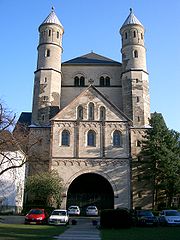
Westwork
Encyclopedia

Carolingian architecture
Carolingian architecture is the style of north European Pre-Romanesque architecture belonging to the period of the Carolingian Renaissance of the late 8th and 9th centuries, when the Carolingian family dominated west European politics...
, Ottonian
Ottonian architecture
Ottonian Architecture is an architectural style which evolved during the reign of Emperor Otto the Great . The style was found in Germany and lasted from the mid 10th century until the mid 11th century....
, or Romanesque
Romanesque architecture
Romanesque architecture is an architectural style of Medieval Europe characterised by semi-circular arches. There is no consensus for the beginning date of the Romanesque architecture, with proposals ranging from the 6th to the 10th century. It developed in the 12th century into the Gothic style,...
church. The exterior consists of multiple stories between two towers. The interior includes an entrance vestibule
Vestibule (architecture)
A vestibule is a lobby, entrance hall, or passage between the entrance and the interior of a building.The same term can apply to structures in modern or ancient roman architecture. In modern architecture vestibule typically refers to a small room or hall between an entrance and the interior of...
, a chapel
Chapel
A chapel is a building used by Christians as a place of fellowship and worship. It may be part of a larger structure or complex, such as a church, college, hospital, palace, prison or funeral home, located on board a military or commercial ship, or it may be an entirely free-standing building,...
, and a series of galleries overlooking the nave
Nave
In Romanesque and Gothic Christian abbey, cathedral basilica and church architecture, the nave is the central approach to the high altar, the main body of the church. "Nave" was probably suggested by the keel shape of its vaulting...
. This was used to show imperial rule and the interiors are thought to be influenced by many cultures, including China.
The westwork first originated in the ancient churches of Syria although some early examples were in Spanish buildings.
The westwork of Corvey Abbey
Corvey Abbey
The Imperial Abbey of Corvey was a Benedictine monastery on the River Weser, 2 km northeast of Höxter, now in North Rhine-Westphalia, Germany....
(873-885), Germany
Germany
Germany , officially the Federal Republic of Germany , is a federal parliamentary republic in Europe. The country consists of 16 states while the capital and largest city is Berlin. Germany covers an area of 357,021 km2 and has a largely temperate seasonal climate...
, is the oldest extant example. The frescos (originally of the 9th century) inside the westwork show scenes from the Odyssey
Odyssey
The Odyssey is one of two major ancient Greek epic poems attributed to Homer. It is, in part, a sequel to the Iliad, the other work ascribed to Homer. The poem is fundamental to the modern Western canon, and is the second—the Iliad being the first—extant work of Western literature...
. The King, later the Emperor
Holy Roman Emperor
The Holy Roman Emperor is a term used by historians to denote a medieval ruler who, as German King, had also received the title of "Emperor of the Romans" from the Pope...
, and his entourage lodged in the westwork when visiting the abbey during their travels around the country.

Norman architecture
About|Romanesque architecture, primarily English|other buildings in Normandy|Architecture of Normandy.File:Durham Cathedral. Nave by James Valentine c.1890.jpg|thumb|200px|The nave of Durham Cathedral demonstrates the characteristic round arched style, though use of shallow pointed arches above the...
in the 11th century by Robert of Jumièges
Robert of Jumièges
Robert of Jumièges was the first Norman Archbishop of Canterbury. He had previously served as prior of the Abbey of St Ouen at Rouen in France, before becoming abbot of Jumièges Abbey, near Rouen, in 1037...
at the church of Jumièges Abbey
Jumièges Abbey
Jumièges Abbey was a Benedictine monastery, situated in the commune of Jumièges in the Seine-Maritime département, in Normandy, France.-History:...
, consecrated in 1067. The pattern was continued in German Gothic architecture
Gothic architecture
Gothic architecture is a style of architecture that flourished during the high and late medieval period. It evolved from Romanesque architecture and was succeeded by Renaissance architecture....
.

